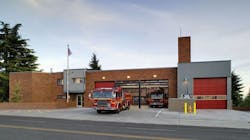Seattle FFs Move Out of Station Known as 'Cancer House'
Seattle authorities have moved firefighters out of a Northgate fire station where worries have long been raised about unhealthy conditions and links to cancer.
Mayor Jenny Durkan and Fire Chief Harold Scoggins made the relocation decision this week, citing initial results from environmental testing recently done at Station 31 by the Seattle firefighters union, Local 27. Crosscut first reported the action.
Though the city has tested Station 31 in the past and cleared the building for use, firefighters have repeatedly expressed concerns about the conditions and referred to the structure as “Cancer House.” Many firefighters who have worked at Station 31 have been diagnosed with the illness.
The initial results from Local 27’s testing indicate there may be mycotoxins, a byproduct of some molds, in some parts of the building, the mayor’s office and Fire Department said in a statement.
The statement described Wednesday’s move as a temporary, precautionary measure while more testing is done.
Seattle is having NVL, a company that specializes in industrial hygiene, test Station 31 for mycotoxins and mold spores, according to the statement. A second company, Kester, will also test the building for mycotoxins, according to the city. The testing began Tuesday, using surface and air samples.
“The mayor and fire chief will continue taking necessary steps to protect the health and safety of all (Fire Department) members,” the mayor’s office and Fire Department said.
The city previously conducted testing of various kinds at the station five times over 15 years, checking for mold in 2004 and 2016 and checking air quality last year.
“Experts have indicated the building is safe,” the mayor’s office and Fire Department said.
The evacuated firefighters will, for now, work out of other North Seattle stations: Ladder 5’s four firefighters will be at Station 39 in Lake City; Medic 31’s two firefighter-paramedics will be at Station 35 in Crown Hill; Aid 31’s two firefighters at Station 24 in Bitter Lake; and Engine 31’s four firefighters at Station 17 in the University District.
Firefighters spoke out in the early 2000s, after a string of them who had spent time at Station 31 were diagnosed with cancer and two died.
A subsequent study found no links between the building and the sickness.
Research has shown that firefighters, in general, are at unusually high risk for cancer because the blazes they douse routinely expose them to dangerous substances, including carcinogens.
The question about Station 31 was revived when a healthy firefighter with no family history of brain cancer was diagnosed with it, forcing his retirement in 2016.
Scoggins connected with scientists at the Fred Hutchinson Cancer Research Center, who agreed to investigate whether Station 31 firefighters were being diagnosed with cancer at higher rates than those at other Seattle stations.
“We know cancer is an issue for the fire service,” Scoggins said at the time. “But we would like to know if we’re causing that ourselves.
The city is spending $400,000 on the Fred Hutch study, which began last year and for which results were said to be expected this summer.
“Firefighters have a dangerous job,” the mayor’s office and Fire Department said. “Seattle is committed to monitoring our dedicated workers and ensuring we don’t have any elevated problems because of their working conditions.”
———
©2019 The Seattle Times
Visit The Seattle Times at www.seattletimes.com
Distributed by Tribune Content Agency, LLC.
